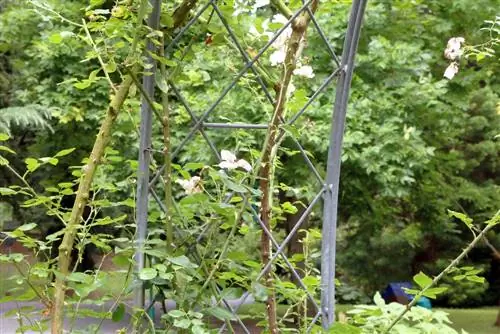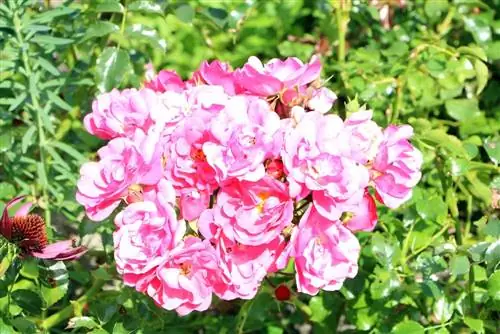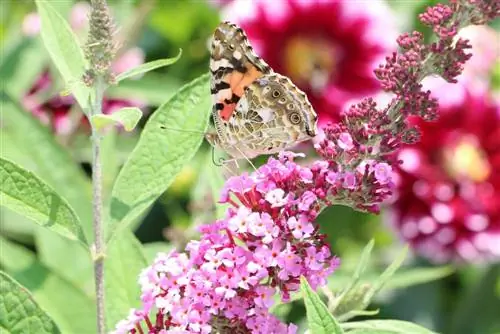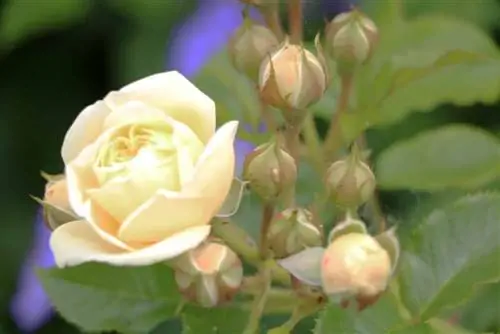- Author admin [email protected].
- Public 2023-12-17 03:39.
- Last modified 2025-01-24 12:45.
Depending on the variety, you can cut the climbing roses just once or several times a year. Properly carried out pruning is important for care and crucial for beautiful growth, lush growth and attractive flowers. Young plants should not be pruned so that they can develop undisturbed.
When is the best time?
In view of the wilted roses, many gardeners want to start pruning in the fall in order to trim the plant and give it the desired shape. However, this point in time is fatal for the plants because in this phase the urgently needed nutrients flow back from the leaves into the shoots. In this way, the roses strengthen themselves for the winter and increase their resistance to the upcoming drops in temperature. The forsythia flower offers a useful clue as a guide to the right time. When their yellow flowers begin to sprout, the climbing roses can be cut safely.
- The best time to prune is at the beginning of spring
- Do not prune until after the last frost nights
- In mild winter conditions, prune in late winter
- Do not prune climbing roses until they are second or even third year old
- If possible, do not prune annual shoots
- Cut once-blooming climbing roses only once a year
- Shrink more frequently flowering varieties up to three times a year
- Never use rose scissors in autumn
- Autumn pruning only weakens the roses unnecessarily
Pruning instructions
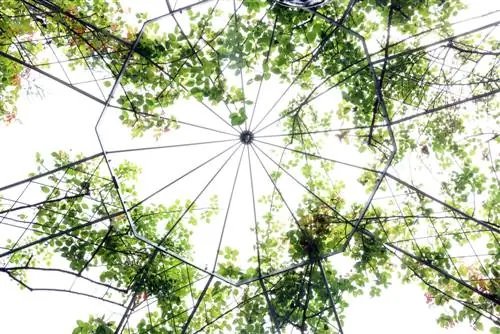
Climbing roses grow both in height and width and can reach large format dimensions. They can be created in many shapes, for example as a rose arch. The flowers impress with their varied colors; some varieties even bloom several times a year. However, the gardener must intervene by pruning, otherwise the flowers of the climbing artists cannot develop in the long term.
Pruning regularly also prevents the shoots from becoming longer and therefore weaker. In addition, correct pruning promotes the development of the flowers and the roses develop significantly more foliage.
- Only shorten the two to three year old shoots
- Leave 3-5 eyes on the rose shoot
- Remove old shoots in favor of young shoots
- Cut off diseased shoots in good time
- Always cut back slightly at an angle
- Cut about 5 mm above the knot
- Always trim above the outward-facing eye
- Place the scissors as close as possible to the trunk
- Special rose scissors are ideal
- Disinfect and sharpen tools well before use
Instructions for maintenance pruning
The aim of this pruning is to preserve the he althy and vital properties of the climbing roses. The focus is on optimizing the existing growing conditions to promote beautiful flowering. Winter and its extreme weather conditions put a strain on the plant and often cause damage. Damaged plant parts are often the cause of incipient baldness or senescence, which leads to unsightly growth.
The maintenance cut is a good time to check the climbers for possible fungal infections or pest infestation. If the first small signs of this already appear, the affected parts of the plant should be removed generously. This is the only way to prevent further spread and nip it in the bud.
- Prolonged frost and heavy hail often cause damaged shoots
- Remove damaged shoots generously
- Short dry and old branches directly at the base
- Cut off poorly growing branches
- Prune shoots that grow too inwards
- Remove criss-crossing branches
- Only cut perennial rose shoots
- Trim two- and three-year-old branches to 3 to 5 eyes
- Do not prune annual branches
- Tie these up with a climbing aid
- Do not dispose of diseased or infected clippings in the compost
- Throw into household waste to prevent further spread
Tip:
Pay particular attention to the fact that the bushy growth of climbing roses looks very distinctive. To promote this, you should repeatedly attach the annual shoots to the rose trellis either horizontally or diagonally.
Rejuvenation cut instructions
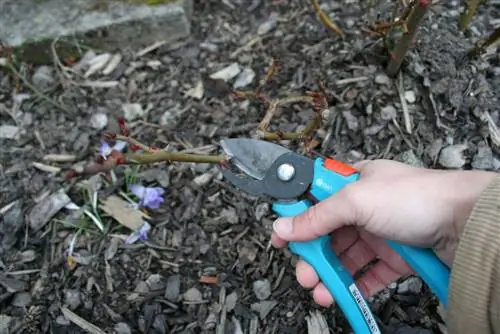
With climbing roses, it is desirable that they climb nicely in height and width. The goal is a densely overgrown rose trellis or a colorful display of flowers on the rose arch. To achieve this, climbers need appropriate care steps that differ from normal rose bushes. For this reason, these special roses must be pruned regularly so that their he alth is maintained and they can sprout vigorously.
Only in this way does the plant put its strength into young shoots and not into the growth of old branches. Otherwise, the older branches will stretch out more and more and become much too thin. As a result, the growth appears uneven and the flowers only develop poorly. The result is aging plants that can only flower at the tips of the branches. In addition, the roses are weakened without pruning and are therefore more susceptible to pests and fungal attack.
- Prune half of the perennial branches
- Shorten to approximately 30 cm above the ground
- Prune branches that are too long and old
- Remove diseased and damaged branches
- Short side and short shoots down to 2 eyes
- The following year cut off the rest of the old branches
- Carry out rejuvenation pruning, especially on neglected plants
- Remove wild shoots at the same time
- Carefully expose the rootstock
- Tear down water bullets with one courageous move
Care errors
If the cut is made incorrectly, the plant's immune system is weakened and it becomes more susceptible to diseases and pest infestation. The right time also plays an important role; this depends on the rose variety and should be found out before pruning. Since the plants have no adhesive roots, they use their thorns as climbing aids.
If there is not enough support, the branches can quickly break in strong winds. In addition, roses need rest at the end of the year in order to recharge important energies.
- Be sure to avoid stunted branch stubs
- Only prune if pruning is absolutely necessary
- Do not prune young plants in the first year
- Choose the right surface, not all places are suitable
- Don’t forget sturdy trellises
- Avoid exposed locations with a lot of wind
- Do not use dirty tools, disinfect with alcohol
- Do not use dull rose scissors, sharpen them before use
- Never prune in autumn
- Do not leave faded plant parts on the plant for too long
Single-blooming climbing roses
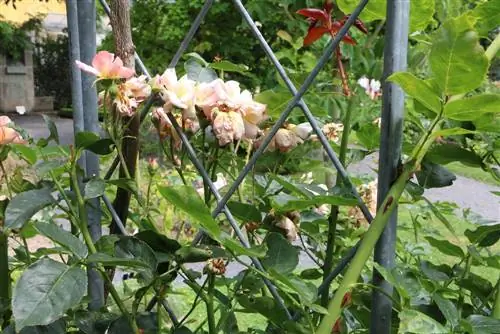
Most rambler roses are among the once-blooming varieties. These have particularly strong growth and can reach heights of more than six meters. That's why these varieties are ideal for house walls and tall trees. But the rambler roses also look very distinctive on a rose trellis with their flat growth, which shows off the flowers beautifully.
Since the lower parts of the plant are usually leafy, there are no bare or unsightly spots. These properties are ideal for creating a privacy screen. For very tall specimens, pruning in summer poses a safety risk and reduces flowering.
- In spring, a small and shaping basic cut is sufficient
- Do not bloom on the new shoots
- Only the perennial long shoots produce flowering side shoots in the following year
- Prune climbing roses that only bloom once after flowering
- To do this, shorten most of the main shoots that have already bloomed
- Remove young shoots and dead plant parts that are too weak
- Tie all other branches to the trellis
- Determine the desired shape
- Tie shoots loosely distributed upwards
- Always pay attention to even arrangement
- Arrange rose shoots in an arc, like a fan
Note:
Do not cut away strong annual shoots in spring, otherwise the rose will lack the best wood for flowering.
Frequently blooming climbing roses
Frequently flowering varieties bloom several times throughout the year. However, these grow much weaker than varieties that only bloom once, because they require a lot of energy for the continuous development of the flower. More often flowering climbers can reach heights of two to three meters, making them ideal for creating pergolas and rose arches.
Regular cleaning of the plants increases the flowering of roses that bloom more often. When exactly the various cuts should be made depends on the weather conditions and the plant's ability to bloom. In this case, the gardener should keep an eye on the climbing roses regularly.
- Cut both after the first flowering and in summer
- Pruning in summer increases flower output
- Apply summer pruning more carefully
- Cut off wilted individual flowers from the shorter side shoots
- Also remove spent flower clusters
- Make the cut close to the first, fully developed leaf below the flower
- In this way, the branches produce new flower shoots in the same summer
- Incorporate too many young shoots between the already flowering branches
- In autumn, only shorten extremely long shoots
- These can break off due to snow and strong gusts of wind

